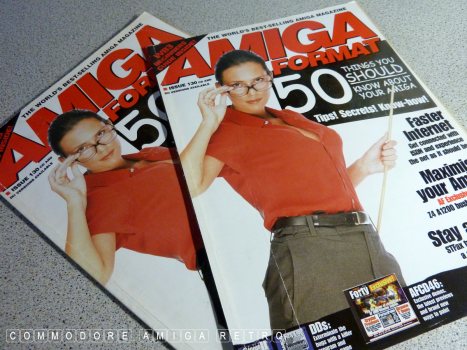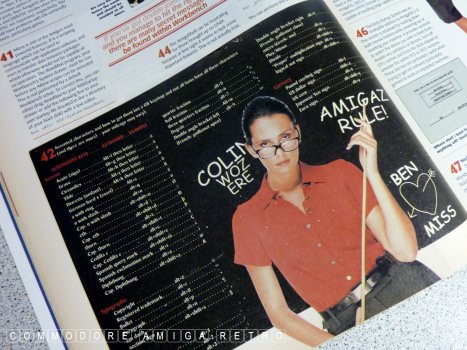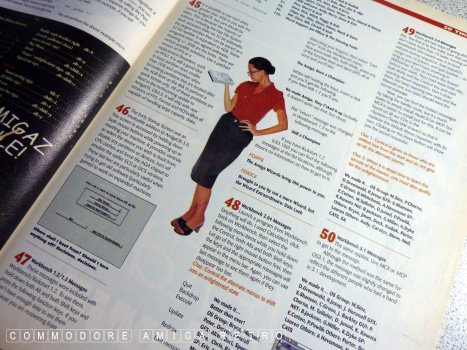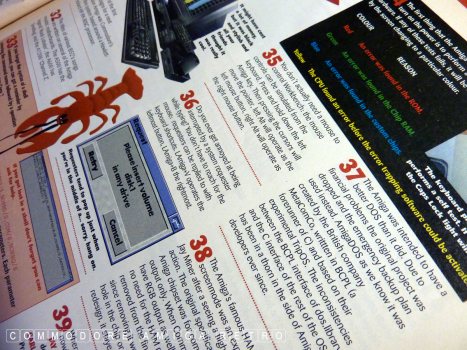ScuzzBlog: Diaries July 2019
Entry 14th July 2019: Post 01: 50 THINGS YOU SHOULD KNOW ABOUT YOUR AMIGA
50 THINGS YOU SHOULD KNOW ABOUT YOUR AMIGA
50 THINGS YOU SHOULD KNOW ABOUT YOUR AMIGA:
1: The A1000 has the signatures of all the Amiga designers in it,
including Mitchy the dog.
2: The A4000`s chip memory jumper that allows you to switch between
2 and 8MB chip RAM ( it doesnít work before you get your hopes up )
was termed the "free beer" jumper by Dave Haynie.
3: The A4000, and AGA, were originally intended as upgrades for
the A3000. You were going to be able to buy a replacement motherboard
with AGA, Ethernet and DSP, but still with SCSI and a hardware
flicker fixer. Commodore got stuck in and made the A4000 the way
it is today.
4: The original name for a system software failure on the Amiga
was a Guru Meditation. The name comes from the early pre-Commodore
days of Amiga development. As a smoke-screen for their real
activities, the Amiga /HiTorro team pretended to be making joysticks
and other game controllers. One of their designs was for a joyboard
a surfboard which could be used as a input device. When a software
failure befell one of the gurus creating the OS, he had to sit on
the joyboard and meditate.
5: AmigaOS will be largely unaffected by the millennium bug that
is causing panic in the majority of the computing world. The AmigaOS
timer.device measures system time as the number of seconds that have
elapsed since January 1 1978 - which it stores as a 32-bit number.
This will overflow some time in 2114. Problems occur with some
other AmigaOS components, however, since they treat this 32-bit
number as signed. From January 19th 2046 03:14:07 the number of
seconds elapsed will be negative and so the date will be invalid.
6: Sam Jordon, the creator of the WarpUp PowerPC kernel for the
Amiga, is a bit of a Trekkie. One of WarpUps housekeeping tasks
is called Enterprise and another Voyager.
7: Amiga spotting is a popular past-time for the die hard Amiga
enthusiasts. It involves noting down every television and film
appearance made by an Amiga computer. Amigas have popped up in
Red Dwarf, Inspector Morse, The Krypton Factor, The Net, Rolf`s
Cartoon Club, Sledgehammer and The Bill.
8: Although by default Arexx is assigned to S: on a standard
start-up sequence, one of the first changes you should make is
to assign it to its own directory, saving your S: directory from
getting clogged up.
9: If you use Directory Opus as a Workbench replacement you can
find a couple of hidden features there too. One is to open the
About requester, hold down Shift then click on the animated logo
repeatedly. The other is to make use of the Eliza program in the
Opus shell by typing "Help me eliza!".
10: The first replacement case for the Amiga - A1500 from Checkmate
Digital - was tested for strength in Amiga Format by standing on it.
11: The word Amiga is not Spanish for girlfriend that would be
`novia`. It just means `female friend`. There you see, your not
that sad, your girlfriend isn`t made silicon, plastic and metal.
12: The names of the custom chipset originated out of a need for
secrecy, much as the original name for the Amiga - Lorriane -
did, It made it easy to talk about the work in a bar without
giving the game away ( although the conversations must have sounded
pretty strange to outsiders )
13: Although the official Commodore Installer is the default used
by programs for their installation, it has never been installed
itself with a Workbench installation.
14: ARexx, the Amiga implementation of Rexx was written way back
in 1987 by William S Hawes. However, it didn`t start to gain in
popularity until it was bundled in free with Workbench 2. Nowadays,
its very rare to find a program that doesnít have some kind of
ARexx port, making the Amiga the most interconnected machine out
there.
15: Although it seems strange for Amiga to be including third-party
software in OS3.5, most of the decent software included with
Workbench versions from 1.2 was actually written by outsider agencies
and licensed by Commodore, including ARexx, CrossDOS, Colorfonts
and MicroEMACS.
16: Work on the Amiga started back in 1982 and the original investors
that came up with the cash to build the machine were three dentists.
17: Jay Miner the `father of the Amiga` also designed the Atari
8-bit range and the Lynx for Atari.
18: People inside the Disney Corporation, Lucasfilm, Virgin, Stena
Sealink, the Barbican theatre used Amigas.
19: Once upon a time, what are now the two Amiga keys on your keyboard
used to have a Commodore logo and the familiar Amiga `A` on them.
20: Donut format high density disks as double density (880KB) disks.
They become far less reliable when you do that. If you donut have
a high density drive, donut use high density disks.
21: Its not a good idea to run Workbench 3.1 on Kickstart 3.0 ROM
chips. Although you might not get into trouble, this combination
can cause problems with datatypes, graphic cards and ATAPI devices.
Youíll need Kickstart 3.1 for when you upgrade to Workbench 3.5
anyway.
22: Our CD`s are snapshot using fonts that can be found on the CD
every issue. We use FuturaB/12 for the screen font, and XHelvetica/
11 for the icons. If you use these fonts youíll find that the
snapshotting will be perfect.
23: The more partitions you have on a hard disk, the more memory
you lose when you boot your machine. A good compromise is to have
three or four drives, one for Workbench, one for programs ( and
if you have another partition you can divide it into two - for
instance work and games ) and one for data, where you can keep
all your pictures, sounds and other files. This should also make
it easier to back up your drive since you probably wont need to
back up the work or games partition too often - just concentrate
on the ever-changing Workbench and Data partitions.
24: Keyboard shortcuts make life a lot easier. Most programs these
days make use of RA-q to quit, but they are also likely to use the
following:
RA-x .....cut
RA-v......paste
RA-p......print
RA-s......Save
RA-o......Open
RA-i......Info
RA-shift..About
25: The ConClip function called in the start-up sequence allows
you to copy text from the shell. You can also use MCX or MCP`s
EditHook function to allow you to copy text from textfields, or
requesters. a lot of MUI textfields also have this ability, meaning
that you have to do far less retyping of important text.
26: If you open up your Amiga, you must give sacrifice to the Blood
God. Without doing so youíll almost certainly find that your machine
doesnít work properly when you put it back together again. The
sacrifice usually takes the form of an irritating scrape of the
knuckles across the cheese grater-like surface of the back of a
Zorro daughterboard, or the slicing open of the fingers on an
unfinished piece of your Amiga casing.
27: Possible the least used command in AmigaDOSis AmgTape. Its
purpose is to control tape drive back-ups. The second least used
command is probably DiskChange. Its intended use is to notify
AmigaOS of when a new floppy is inserted into a 5.25" drive.
Unlike conventional Amiga floppy drives these didnít support a
hardware disk change line.
28: The name Zorro - which applies to the Amiga`s proprietary
expansion bus - is derived from the codename of the first A1000
prototype board to feature an implementation of this bus.
29: A tool called Disk Doctor was shipped with Workbench up to
version 1.3 for repairing damaged disks. It relabelled disks that
it resurrected as Lazarus. Disk Doctor wasnít any good at its job
and was dropped with the advent of WB2.0.
30. CDTV, the first Amiga-based venture into the digital convergence
market doesnít stand for what you might think. It actually means
Commodore Dynamic Total Vision.
31: One of the first designs for a next generation Amiga was
Commodores`s Hombre system based around a Hewlett-Packard HP-PA
RISC processor.
32: The titles of various B52`s songs are written on several of
the Amiga models` motherboards. The A500 has the legend `Rock
Lobster`, the A600 has `Junebug` and the A1200 `Channel Z`.
33: If you forget the syntax of a shell command, you can get a
reminder by entering the command name followed by a question mark.
For example, typing Copy ? will display.. FROM/M, TO/A, ALL/S,
QUIET/S, BUF=BUFFER/K/N, CLONE/S, DATES/S, COM/S, NOREQ/S This is
the argument template for the copy command, a comma-separated
list of all its perimeters. Each parameter may also have a modifier
specified to define its type.
34: The first thing that the Amiga does when you turn on the power
is to perform a check on its hardware. If any of these tests fails,
it will be signified by the screen changing to a particular colour.
Colour - Reason
Red An error was found in the ROM
Green An error was found in the Chip RAM
Blue An error was found in the custom chips
Yellow The CPU found an error before the error
trapping software could be activated.
The keyboard processor also performs a self test. If this fails the
Caps Lock light will flash.
35: You don`t actually need a mouse to control Workbench: the mouse
controls can be simulated from the keyboard. Press and hold down
the left Amiga key. Then pressing
the cursors will move the pointer, left Alt will operate as the
left mouse button, Alt will operate as the right mouse button.
36: Do you ever get annoyed at being interrupted by a system requester
while typing ? You don`t have to reach for the mouse: requesters
can be replied to with keyboard shortcuts. LAmiga+V operates the
leftmost button, LAmiga+B the right
most.
37: The Amiga was intended to have a better DOS than it did. Due
to financial problems the original project was dropped and the
emergency back-up plan used instead. AmigaDOS as we know it was
created by the British company MetaComCo, written in BCPL ( a
forerunner of C ) and based on their experimental TripOS. The
inconsistencies between the BCPL interface of dos.library and the
C interface of the rest of the OS has been a thorn in the side of
Amiga developers ever since.
38: The Amiga`s famous HAM screenmode was an experiment by Jay Miner
after seeing a flight simulator in action. The original specification
for the Amiga chipset was for composite video output only. When
Commodore agreed to
have RGB output as well, Jay said there was no need for the HAM
mode and wanted it removed from the final silicon. However, since
removing it would have left a gaping hole in the chip or required
a costly redesign, it stayed. The rest is history.
39: Where are they now -
Jay Miner - deceased
Carl Sassenrath - President Rebol
RJ Mical - Former VP 3DO
Dale Luck - Master Software Architect 3DO
Andy Finkel - Met@box Infonet
Dave Haynie - V.P. Technology Met@box Infonet
Michael Sinz - NextBus ( produces information for PT )
40: You do not actually need a scandoubler to display your Amiga`s
native video output on a VGA monitor, although you will probably
require a 23pin-15pin converter so that you can connect the VGA
lead to your Amiga`s RGB port. If the VGAOnly monitors driver is
present in your DEVS:Monitors drawer then the Multiscan, DblPAL
and DblNTSC modes get tweaked to VGA frequencies. Also if you
specify the Mode Promotion option in Workbench`s IControl prefs,
then AmigaOS will open DblPAL and DblNTSC modes when PAL and NTSC
are requested, respectively. You will still have problems with
OS-unfriendly software, particularly games.
41: ARexx is one of the Amiga`s most powerful features. It is a
scripting language which can be used to communicate with application
software, and even to transfer data between packages which otherwise
would not be capable of co-operation. The RexxMast program your
Workbench System Drawer, must be run before any ARexx scripts can
be executed. This is not performed by default Workbench setup. To
correct this, you can either drag RexxMast to your WBstartup drawer
or add the following line to your user-startup file ( located in
the s directory of your boot disk ) with a text editor.. Run >NIL
SYS:System/RexxMast.
42: You can type accented characters on the Amiga like Acute ( aigu )
Alt+f then letter.
43: AmigaBASIC, the version of Microsoft BASIC that was shipped
with AmigaOS up to release 1.3 is not very Amiga friendly. It
multitasks poorly, uses some 68000 instructions which are privileged
on higher processors and will not work on machines with 32-bit
memory such as A1200`s with an accelerator card.
44: The AmigaShell can be frustrating for those brought up on UNIX
because at first sight it seems to lack some important features.
This is not actually true, it`s just that some features are well
hidden. For example, the Amiga equivalent of the UNIX ''. to
represent the current directory is simply the empty string "". To
copy the file RAM:foobar to the current directory, type :
Copy RAM:foobar ""
By default, the AmigaShell does not handle pipes very well. This
can be improved with the Pipe command. However, it is not shipped
with AmigaOS by default, but is available from the Aminet at util/
cli/finkelshelltools.lha. you can then do things like: Pipe List |
More to display the contents of the current directory with More.
45: It is possible to use hard disks greater than 4GB in size with
the current AmigaOS, but care should be taken. This is because the
majority of software, including the FastFile System itself, accesses
disksvia 32-bit arithmetic: the largest number that can be
stored is a 32-bit number is equivalent to 4GB. Some programs even
use signed arithmetic, meaning +/- 2GB are the limits . There are
various possible solutions. Use a patched version of FFS or a
replacement filesystem such as PFS2. It is still a good idea to keep
partition sizes smaller than 2GB and remember when formatting
partitions that are located after the 4GB limit on the disk to
perform a quick format only. All of these problems are fixed in the
forthcoming update to AmigaOS, OS3.5. It will ship with new versions
of FFS, Format and HDToolBox all capable of handling large capacity
disks.
46: The Early Start-up Screen was an invaluable addition of AmigaOS 3.0.
This screen is accessed by holding down both mouse buttons while
powering up or resetting the machine . It provides controls to select
the device you wish to boot from, disable any partitions or devices,
turn off CPU caches and force the AGA chipset to emulate earlier
ECS or OCS versions. These last two are particularly useful when
trying to get old software ( particularly games ) to work on expanded
machines.
47: Workbench 1.2/1.3 Messages - These messages were included with
Workbench /Kickstart 1.2. To see them hold down both Alt and both
Shift keys and press the following function keys. If you don`t have
have enough time to see them then select "Last Error" from the
workbench menu.
F1: System Software: Carl, Neil & Kodiak
F2: Graphics Software: Dale, Bart, Jim & =RJ=
F3: QA: Jon, Bruce, Stan , Kim & Jerry
F4: LG Support: Caryn, Dave , Victor, Terry, Cheryl
& Nancy
F5: CBM software: Andy, Barry, Dave & Eric
F6: Pics: Sheryl & Jack
F7: Docs: Rick, Mitch, Peggy & Rob
F8: Chips: Jay, Akio, Glenn, Edwin, Mark & Dave
F9: HW: Dave, Bill, ChrisR & Josh
F10: Moral support: Joe Pillow & The Dancing Fools
Now press both Alts, both Shifts, press any other function keys and
eject DF0: all at once and you`ll see :
The Amiga, Born a Champion
48: Workbench 2.04 Messages:
Launch a program from Workbench ( anything will do, I used calculator ),
click back on Workbench, then select the following menu items while
you hold down the Control, both Alts and both Shift keys. Let go
of the right mouse button first then the keys and the appropriate
messages will appear in the menu bar.
Quit We made it...
Backdrop Better than ever !
Execute OS Group: Bryce, Michael
Peter, Darren, Randell
Update GFX: Allan, Bart, Spence
Steve, Chris, Ray
Redraw SP: Eric, Martin H, Bill,
Martin T., Brian, Kevin
Last Message Other: Andy, Dale, Jimm,
Kodiak, Ned, Porter,
Carolyn, David, Cats, QA
About Thanks to Bill Hawes,
Software Distillery
49: Workbench 3.0 Messages - There are two ways of going about this.
The first is to make sure that you don`t have more than 15 tasks
running on Workbench ( the easiest way to boot without start-up
sequence, load setpatch, assign env: to envarch: and type loadwb
- as long as you don`t have anything in WBStartup. If you do rename
the drawer before you start ) Then hold down both Alts, both Shifts
and the Control key and start opening About requesters. Don`t close
them, but keep opening new ones and the fifteenth one
you open should have the secret message...
We made it... OS Group: M.Sinz, P.Cherna D.Greenwald, R.Jesup GFX:
S.Shanson, C.Green, B.Whitebook, A.Havemose Sp: E.Cotton, M.Taillefer,
D.Junod, P.Pawlik, K.Kuwata Net: B.Jackson, G.Miller K.Dyke. Others:
Bryce, Jimm, Duck, Kodiak, Porter, Lauren Others: Andy, Carolyn,
Steve, Ned, CATS, SA.
50: Workbench 3.1 Messages - The same applies..
We made it ... OS Group: M.Sinz, D.Greenwald, R.Jesup, J.Horanoff
GFX: S.Shanson, C. Green, J. Barklay GUI: P.Cherna, M. Taillefer,
D. Junod, K. Kuwata NET: B. Jackson, G. Miller, K. Dyke SP: E.
Cotton, P.Pawlik Others: Porter, Bryce, Lauren, Others:
A Havemose, Ned, Carolyn, CATS.
50 Things you should know about your Amiga was brought to you by
Ben Vost and Richard Drummond for Issue 130 of Amiga Format Dec 1999.
Amiga Format produced and published by Future Publishing.
KNOW YOUR AMIGA










|


![]()


![]()